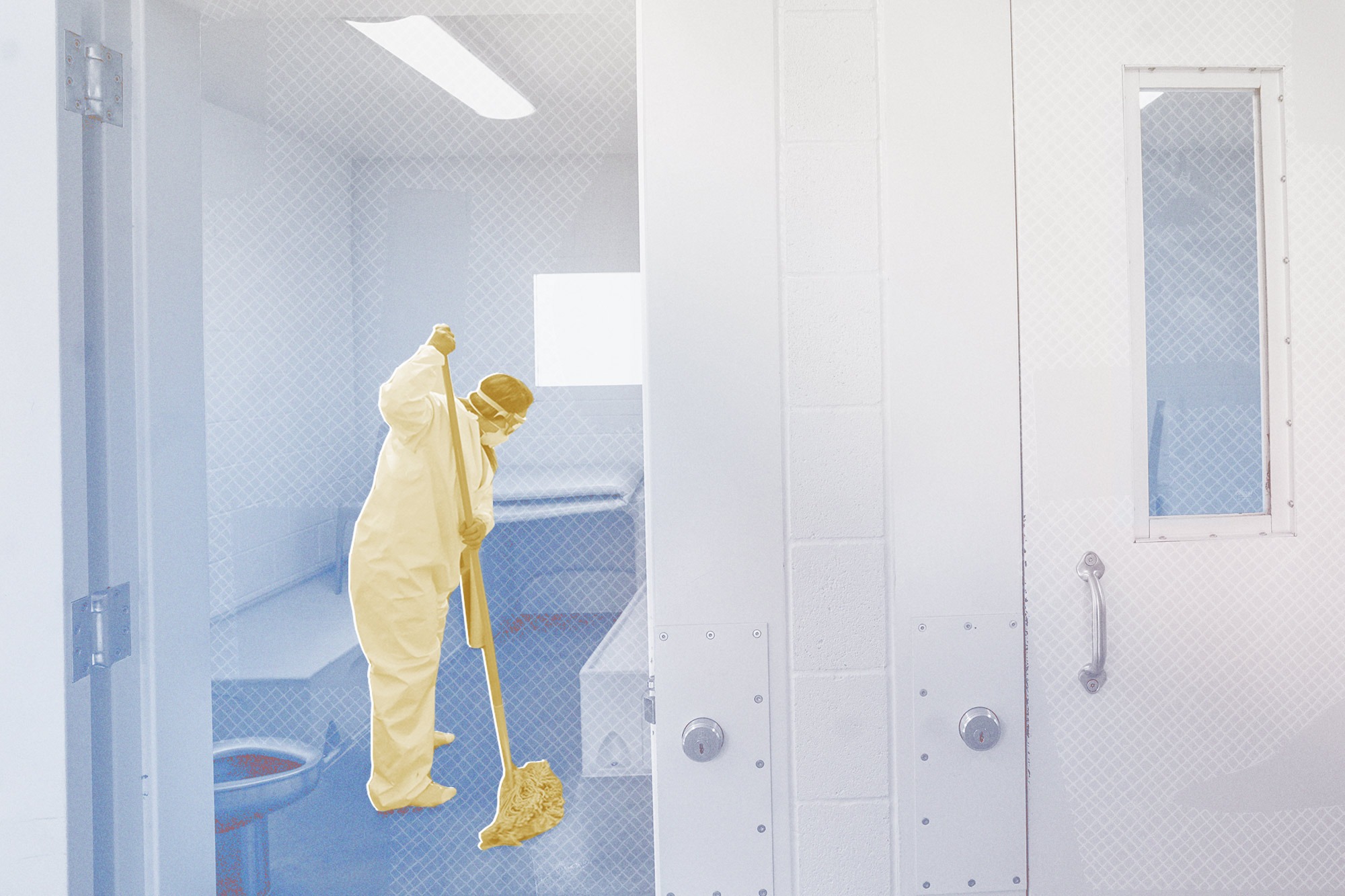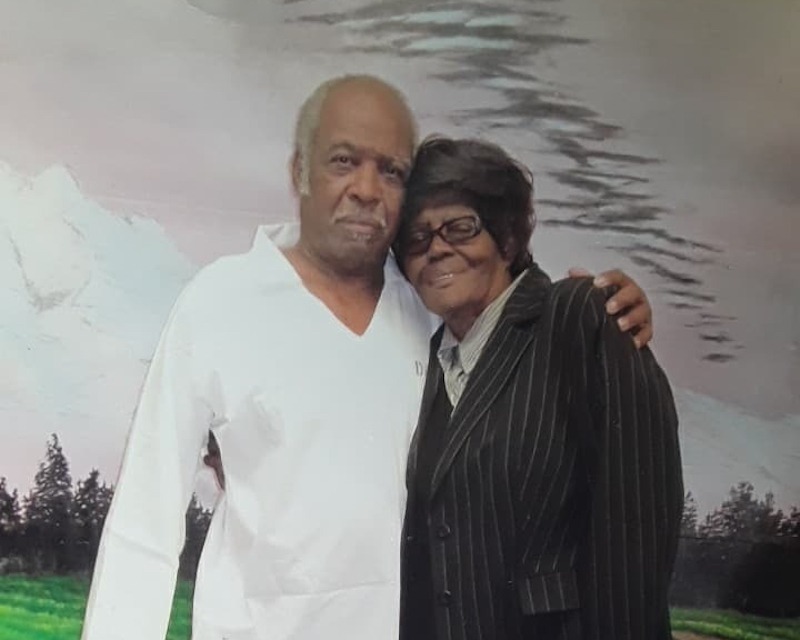Grim Stories From Inside An Arkansas Prison Capture The Toll Of Covid-19
The accounts by prisoners in Cummins Unit contradict messaging from the state Department of Corrections, which says it has taken aggressive steps to stop the spread of coronavirus.

On May 6, Evelyn Lamar called the Arkansas prison where her husband, Roy E. Davis, had been incarcerated for the last three decades. Three weeks earlier, on April 12, he had sent her a letter laden with ominous biblical scripture, which she interpreted to mean that conditions within the facility, Cummins Unit, were deteriorating under the threat of the COVID-19 pandemic. The day Davis mailed the letter, Cummins officials announced that the facility had its first prisoner case of the disease. A week later, 600 prisoners—nearly a third of the prison population—were confirmed to have the disease.
One of the results of the pandemic was staffing shortages at Cummins, and because of that prisoners were not getting enough to eat, Lamar had heard. Pictures posted on social media pages for prisoners’ family members showed scant offerings—a soy patty on a biscuit and an apricot, two pools of brown mush filled tray holes next to a piece of french bread. On the May 6 telephone call, Lamar told the person on the other end of the line to put $80 on Davis’s books. It would be plenty for him to purchase food from the commissary to supplement his meals, she thought. She was told that wasn’t possible. Davis, 76, had died at 8 that morning of COVID-19.
Lamar was stunned. Nobody had told her that her husband had been diagnosed with the disease. Too distraught to make a decision about what would happen to Davis’s body, she told the staffer that she would call back once she had time to process what she had learned. She called the prison the next day and was told that he had already been cremated.
“I was just torn apart,” Lamar told The Appeal. “I didn’t even get to talk to anybody about what I wanted.”
Davis was one of 10 COVID-19 related deaths at the facility since the pandemic exploded there in April. Since then, 963 prisoners and 65 staff members have tested positive. At one point, Lincoln County, where the prison is located, had the third-highest infection rate in the country, the Washington Post reported. As of June 15, 952 prisoners have recovered, according to a DOC spokesperson.
As the novel coronavirus spread throughout Cummins, a prison farm in the Arkansas Delta region 75 miles from Little Rock, family members of people incarcerated there followed along in horror, fielding telephone calls and letters from prisoners who detailed what they described as a failed effort to contain the disease. These accounts contradicted messaging from the state Department of Corrections (DOC), which said that it had been taking an aggressive approach to stopping the spread.
In Arkansas, Black people are incarcerated at four times the rate of white people. In a state where Black people make up just 16 percent of the population as a whole, they make up 30 percent of the confirmed COVID-19 cases and 31 percent of deaths. The outbreak at Cummins would follow the same pattern, disproportionately affecting Black prisoners.
The narratives of the prisoners and their loved ones went on to form the basis of a federal lawsuit filed on behalf of prisoners in April. Drawing on affidavits and hundreds of pages of correspondence between Arkansas prison officials obtained as part of the lawsuit, attorneys painted a grim picture of life inside Cummins as COVID-19 took over. These stories mirrored those told by prisoners and their loved ones in interviews with The Appeal.
Though Governor Asa Hutchinson declared a state of emergency on March 11, prison officials allowed people displaying symptoms of COVID-19 to continue working into April. One woman, who spoke to The Appeal on the condition of anonymity because she feared retribution, said her friend, a kitchen worker, was coughing and had shortness of breath. While he awaited his test results, he kept working in the kitchen preparing meals for prisoners at Cummins and a nearby facility.
Then, once people began to test positive, officials played a game of “musical chairs,” rotating prisoners who tested negative—but had lived among others confirmed to have coronavirus—into other dorm-style barracks with no confirmed cases. “If you have a barracks full of those who test positive and two did not, they end up moving those inmates into a different barracks,” said the woman. One prisoner wrote in a letter shared with The Appeal that he was tested for coronavirus in the morning and officials moved a prisoner from a COVID-positive wing into his cell later that day. “The paper said I tested negative but what good did the test do me if 8.5 hours later move someone from quarantine in with me?”
Additionally, Arkansas contradicted national guidance when it allowed some staff members who were infected by the disease to continue to work. The Arkansas Department of Health issued guidance to the DOC on April 15 declaring that staff members who tested positive but did not show symptoms could return to work where there is a “critical shortage of workers and critical activities cannot occur without the use of these workers.” In an email to the staff, DOC director Dexter Payne acknowledged that asymptomatic people can transfer the disease but in other messages he encouraged them to work anyway.
Payne testified in a hearing as part of the federal lawsuit last month that fewer than 10 COVID-19 positive asymptomatic staff members reported to work at Cummins. This was in addition to a staff member who worked at a facility two and a half hours away who reported to work at Cummins because Payne said asymptomatic staffers could only work in units with confirmed cases.
The Arkansas Department of Health alerted the DOC in early March that prisoners were especially vulnerable to COVID-19, but officials did not require that staff wear face masks until April, emails exchanged between DOC officials show. This shift came after Payne told staff that hospitals were hesitant to treat prisoners because correctional officers who transported them there were not wearing masks. And though Cummins prisoners made cloth masks for the majority of prisoners in the state, not everyone inside the facility was given one to wear. Prisoners in segregated housing, who are locked in cells with one other person, were not given masks because they were found to be “unnecessary to safeguard” against the spread of the disease in that area of the prison, according to court filing by the DOC. “Guys have to pass in front of a cell without masks on,” one prisoner in segregated housing said. The two men housed two cells down from him tested positive, he said.
Arkansas prison officials have maintained that their actions were sufficient to guard against a COVID-19 outbreak, calling their actions “immediate, proactive, and comprehensive” in a court filing made as part of the federal lawsuit. Arguing for the court to reject their requests for relief, the DOC wrote that the prisoners behind the lawsuit are “murderers, rapists, armed robbers, arsonists, and repeat violent offenders.”
Attorneys asked a federal district court judge to step in and force the DOC to implement “basic measures” to help protect against and stop the spread of coronavirus in addition to ordering the release of vulnerable prisoners. That judge, Kristine Baker, denied their requests for a preliminary injunction last month, finding that prisoners had failed to show they were likely to succeed on their claims that the DOC showed deliberate indifference to the spread of coronavirus. A trial has been set for April 2021.
Lamar hadn’t visited her husband for more than a year before his death, a time lapse she credits to officials taking her off his visitation list. The pair had been for together for nearly four decades, most of which he spent incarcerated for murder.
She described Davis as a “real good outgoing person” who had become a minister at Cummins. When he was younger, Davis was incarcerated at the Arkansas Negro Boys Industrial School, a facility for Black boys that burned down in 1959. The blaze killed 21 boys. Davis had saved some of the 48 boys who survived, Lamar said.
A picture of the couple taken during a prison visit sits in her living room. It’s one of the few things she has to remember her husband by; she said that she doesn’t know where his prison belongings are, including his ring.

She gave his ashes to his niece, who she and Davis helped raise. “I said I don’t care who gets them,” she said. “Every day I’d be looking at them and be crying.”
Those whose loved ones are still alive started executing powers of attorney at the beginning of the outbreak so they could make medical decisions should a prisoner contract COVID-19. “It’s pretty much the only way that we can get ADC [the Department of Corrections] to acknowledge us as next of kin that they have to notify in case of emergency also,” said LaDeana Biddle, an activist whose son is incarcerated at Cummins.
Through social media, Biddle has organized prisoners’ loved ones to raise awareness about the situation inside Cummins. In a group Facebook message last month, they swapped stories and inspiration.
“I have been in tears and wanting to give up cause he called and said they shook him down—threw pictures of his kids on the floor and walked over them—threw letters on the floor and he told me don’t you dare give up—I need you to keep fighting to be my voice!” wrote one woman.
Biddle replied, “It would be so much easier to give up but if they aren’t giving up then neither am I.”
“Our voices are definitely being heard. We just have to keep going ladies and stay strong,” wrote another.
